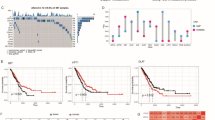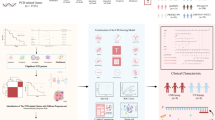Abstract
Skin cutaneous melanoma (SKCM) is the most malignant skin tumor for it is enormously easy to develop invasion and metastasis. Autophagy is a process by which cellular material is degraded by lysosomes or vacuoles and recycled. Autophagy-related long non-coding RNAs (lncRNAs) have been thought to correlate with SKCM. This study aims to explore the prognostic significance of autophagy-related lncRNAs and establish a prognostic model of autophagy-related lncRNA pairs in SKCM. Firstly, the RNA-seq data and related clinical information were downloaded from the TCGA database. 446 qualified samples were enrolled. 222 autophagy-related genes were obtained from the HADb database. Pearson correlation analysis was conducted to identify autophagy-related lncRNAs (ARLs). After that, we obtained prognosis-related ARLs and autophagy-related lncRNA pairs (ARLPs). Using Lasso-Cox regression analysis, an autophagy-related lncRNA-pair prognostic signature was established. The accuracy of the signature were confirmed through a series of validations in terms of mutation profiles, immunity infiltration, and cellular pathways. And we used the random forest method to find USP30-AS1 as a key mediating factor in SKCM.








Similar content being viewed by others
Data availability
Not applicable.
Abbreviations
- SKCM:
-
Skin cutaneous melanoma
- lncRNA:
-
Long non-coding RNA
- ARLs:
-
Autophagy-related lncRNAs
- ARLPs:
-
Autophagy-related lncRNA pairs
- AMBRA1:
-
Beclin 1-regulated autophagy protein 1
- AC:
-
Acid ceramidase
- ARGs:
-
Autophagy-related genes
- TCGA:
-
The cancer genome atlas
- HADb:
-
Human autophagy database
- KM:
-
Kaplan–Meier
- PRARLs:
-
Prognosis-related ARLs
- Coef:
-
Coefficient
- ROC:
-
Receiver operator characteristic curve
- DSS:
-
Disease specific survival
- CCM:
-
Calibration curve method
- C-index:
-
Concordance-index
- DCA:
-
Decision curve analysis
- TMB:
-
Tumor mutation burden
- GSEA:
-
Gene set enrichment analysis
- WGCNA:
-
Weighted gene co-expression network analysis
- TOM:
-
Topology overlap measurement
- GS:
-
Gene significance
- MS:
-
Module significance
- TIP:
-
Tracking tumor immunophenotype
- IPS:
-
Immunophenoscore
- HRs:
-
Hazard ratios
- CIs:
-
Confidence intervals
- VAF:
-
Variant allele frequency
- CTLA-4:
-
Cytotoxic T-lymphocyte-associated protein 4
- PD-1:
-
Programmed cell death-1
- USP30-AS1:
-
USP30 antisense RNA 1
References
Davis LE, Shalin SC, Tackett AJ (2019) Current state of melanoma diagnosis and treatment. Cancer Biol Ther 20(11):1366–1379. https://doi.org/10.1080/15384047.2019.1640032
Namikawa K, Yamazaki N (2019) Targeted therapy and immunotherapy for melanoma in Japan. Curr Treat Options Oncol 20(1):7. https://doi.org/10.1007/s11864-019-0607-8
Rastrelli M, Tropea S, Rossi CR, Alaibac M (2014) Melanoma: epidemiology, risk factors, pathogenesis, diagnosis and classification. In Vivo 28(6):1005–1011
Yun CW, Lee SH (2018) The roles of autophagy in cancer. Int J Mol Sci. 19(11):3466. https://doi.org/10.3390/ijms19113466
Mowers EE, Sharifi MN, Macleod KF (2018) Functions of autophagy in the tumor microenvironment and cancer metastasis. FEBS J 285(10):1751–1766. https://doi.org/10.1111/febs.14388
Amaravadi R, Kimmelman AC, White E (2016) Recent insights into the function of autophagy in cancer. Genes Dev 30(17):1913–1930. https://doi.org/10.1101/gad.287524.116
Ndoye A, Weeraratna AT (2016) Autophagy- an emerging target for melanoma therapy. F1000Res. https://doi.org/10.1268/f1000research.8347.1
Tang DY, Ellis RA, Lovat PE (2016) Prognostic impact of autophagy biomarkers for cutaneous melanoma. Front Oncol. 6:236. https://doi.org/10.3389/fonc.2016.00236
D’Arcangelo D, Giampietri C, Muscio M, Scatozza F, Facchiano F, Facchiano A (2018) WIPI1, BAG1, and PEX3 autophagy-related genes are relevant melanoma markers. Oxid Med Cell Longev. 2018:1471682. https://doi.org/10.1155/2018/1471682
Lai M, La Rocca V, Amato R, Freer G, Pistello M (2019) Sphingolipid/ceramide pathways and autophagy in the onset and progression of melanoma: novel therapeutic targets and opportunities. Int J Mol Sci. 20(14):3436. https://doi.org/10.3390/ijms20143436
Chi Y, Wang D, Wang J, Yu W, Yang J (2019) Long non-coding RNA in the pathogenesis of cancers. Cells. 8(9):1015. https://doi.org/10.3390/cells8091015
Schmitz SU, Grote P, Herrmann BG (2016) Mechanisms of long noncoding RNA function in development and disease. Cell Mol Life Sci 73(13):2491–2509. https://doi.org/10.1007/s00018-016-2174-5
Gutschner T, Diederichs S (2012) The hallmarks of cancer: a long non-coding RNA point of view. RNA Biol 9(6):703–719. https://doi.org/10.4161/rna.20481
Kondo Y, Shinjo K, Katsushima K (2017) Long non-coding RNAs as an epigenetic regulator in human cancers. Cancer Sci 108(10):1927–1933. https://doi.org/10.1111/cas.13342
Peng Y, Tang D, Zhao M, Kajiyama H, Kikkawa F, Kondo Y (2020) Long non-coding RNA: a recently accentuated molecule in chemoresistance in cancer. Cancer Metastasis Rev 39(3):825–835. https://doi.org/10.1007/s10555-020-09910-w
Zhang J, Wang P, Wan L, Xu S, Pang D (2017) The emergence of noncoding RNAs as Heracles in autophagy. Autophagy 13(6):1004–1024. https://doi.org/10.1080/15548627.2017.1312041
Sun T (2018) Long noncoding RNAs act as regulators of autophagy in cancer. Pharmacol Res 129:151–155. https://doi.org/10.1016/j.phrs.2017.11.009
Shu Q, Zhou Y, Zhu Z et al (2022) A novel risk model based on autophagy-related LncRNAs predicts prognosis and indicates immune infiltration landscape of patients with cutaneous melanoma. Front Genet. 13:885391. https://doi.org/10.3389/fgene.2022.885391
Qiu Y, Wang HT, Zheng XF et al (2022) Autophagy-related long non-coding RNA prognostic model predicts prognosis and survival of melanoma patients. World J Clin Cases 10(11):3334–3351. https://doi.org/10.12998/wjcc.v10.i11.3334
Ding Y, Li T, Li M et al (2021) A novel autophagy-related lncRNA gene signature to improve the prognosis of patients with melanoma. Biomed Res Int. 2021:8848227. https://doi.org/10.1155/2021/8848227
Friedman J, Hastie T, Tibshirani R (2010) Regularization paths for generalized linear models via coordinate descent. J Stat Softw 33(1):1–22
Simon N, Friedman J, Hastie T, Tibshirani R (2011) Regularization paths for cox’s proportional hazards model via coordinate descent. J Stat Softw 39(5):1–13. https://doi.org/10.18637/jss.v039.i05
Langfelder P, Horvath S (2012) Fast R functions for robust correlations and hierarchical clustering. J Stat Softw 46(11):i11
Li A, Horvath S (2009) Network module detection: affinity search technique with the multi-node topological overlap measure. BMC Res Notes. 2:142. https://doi.org/10.1186/1756-0500-2-142
Langfelder P, Zhang B, Horvath S (2008) Defining clusters from a hierarchical cluster tree: the dynamic tree cut package for R. Bioinformatics 24(5):719–720. https://doi.org/10.1093/bioinformatics/btm563
Becht E, Giraldo NA, Lacroix L, Buttard B, Elarouci N, Petitprez F et al (2016) Estimating the population abundance of tissue-infiltrating immune and stromal cell populations using gene expression. Genome Biol 17:218. https://doi.org/10.1186/s13059-016-1070-5
Newman AM, Liu CL, Green MR et al (2015) Robust enumeration of cell subsets from tissue expression profiles. Nat Methods 12(5):453–457. https://doi.org/10.1038/nmeth.3337
Aran D, Hu Z, Butte AJ (2017) xCell: digitally portraying the tissue cellular heterogeneity landscape. Genome Biol. 18(1):220. https://doi.org/10.1186/s13059-017-1349-1
Li T, Fan J, Wang B, Traugh N, Chen Q, Liu JS et al (2017) TIMER: a web server for comprehensive analysis of tumor-infiltrating immune cells. Cancer Res 77(21):e108–e110. https://doi.org/10.1158/0008-5472.CAN-17-0307
van Veldhoven CM, Khan AE, Teucher B, Rohrmann S, Raaschou-Nielsen O, Tjønneland A et al (2011) Physical activity and lymphoid neoplasms in the European prospective investigation into cancer and nutrition (EPIC). Eur J Cancer 47(5):748–760. https://doi.org/10.1016/j.ejca.2010.11.010
Tamminga M, Hiltermann TJN, Schuuring E, Timens W, Fehrmann RS, Groen HJ (2020) Immune microenvironment composition in non-small cell lung cancer and its association with survival. Clin Transl Immunology. 9(6):e1142. https://doi.org/10.1002/cti2.1142
Finotello F, Mayer C, Plattner C et al (2019) Molecular and pharmacological modulators of the tumor immune contexture revealed by deconvolution of RNA-seq data. Genome Med. 11(1):34. https://doi.org/10.1186/s13073-019-0638-6
Xu L, Deng C, Pang B et al (2018) TIP: a web server for resolving tumor immunophenotype profiling. Cancer Res 78(23):6575–6580. https://doi.org/10.1158/0008-5472.CAN-18-0689
Barbie DA, Tamayo P, Boehm JS et al (2009) Systematic RNA interference reveals that oncogenic KRAS-driven cancers require TBK1. Nature 462(7269):108–112. https://doi.org/10.1038/nature08460
Balachandran VP, Gonen M, Smith JJ, DeMatteo RP (2015) Nomograms in oncology: more than meets the eye. Lancet Oncol 16(4):e173–e180. https://doi.org/10.1016/S1470-2045(14)71116-7
Peng M, Mo Y, Wang Y et al (2019) Neoantigen vaccine: an emerging tumor immunotherapy. Mol Cancer. 18(1):128. https://doi.org/10.1186/s12943-019-1055-6
Zhang Z, Lu M, Qin Y et al (2021) Neoantigen: a new breakthrough in tumor immunotherapy. Front Immunol. 12:672356. https://doi.org/10.3389/fimmu.2021.672356
Bruni D, Angell HK, Galon J (2020) The immune contexture and immunoscore in cancer prognosis and therapeutic efficacy. Nat Rev Cancer 20(11):662–680. https://doi.org/10.1038/s41568-020-0285-7
Charoentong P, Finotello F, Angelova M et al (2017) Pan-cancer immunogenomic analyses reveal genotype-immunophenotype relationships and predictors of response to checkpoint blockade. Cell Rep 18(1):248–262. https://doi.org/10.1016/j.celrep.2016.12.019
Wang N, Li J, Xin Q, Xu N (2021) USP30-AS1 contributes to mitochondrial quality control in glioblastoma cells. Biochem Biophys Res Commun 581:31–37. https://doi.org/10.1016/j.bbrc.2021.10.006
Chen M, Chi Y, Chen H, Zhao L (2021) Long non-coding RNA USP30-AS1 aggravates the malignant progression of cervical cancer by sequestering microRNA-299-3p and thereby overexpressing PTP4A1. Oncol Lett 22(1):505. https://doi.org/10.3892/ol.2021.12766
Chen P, Gao Y, Ouyang S et al (2020) A prognostic model based on immune-related long non-coding RNAs for patients with cervical cancer. Front Pharmacol. 11:585255. https://doi.org/10.3389/fphar.2020.585255
Sun Z, Jing C, Xiao C, Li T (2020) An autophagy-related long non-coding RNA prognostic signature accurately predicts survival outcomes in bladder urothelial carcinoma patients. Aging (Albany NY) 12(15):15624–15637. https://doi.org/10.18632/aging.103718
Meng C, Zhou JQ, Liao YS (2020) Autophagy-related long non-coding RNA signature for ovarian cancer. J Int Med Res 48(11):300060520970761. https://doi.org/10.1177/0300060520970761
Gao M, Wang X, Han D et al (2021) A six-lncRNA signature for immunophenotype prediction of glioblastoma multiforme. Front Genet. 11:604655. https://doi.org/10.3389/fgene.2020.604655
Acknowledgements
Not applicable.
Funding
The authors have not disclosed any funding.
Author information
Authors and Affiliations
Contributions
YYL and HXZ: are responsible for writing and submitting the papers, collecting and analyzing data, managing all pictures and tables; DLH and SXL: are responsible for the ideas and guidance. The authors have read and approved the final manuscript.
Corresponding authors
Ethics declarations
Conflict of interest
The authors declare that they have no competing interests.
Ethical approval and consent to participate
There are no animal or human trials in our research. No ethical requirements are involved. All data in this study was from public databases, so there was no need for patients to sign the consents.
Consent for publication
Not applicable.
Additional information
Publisher's Note
Springer Nature remains neutral with regard to jurisdictional claims in published maps and institutional affiliations.
Rights and permissions
Springer Nature or its licensor (e.g. a society or other partner) holds exclusive rights to this article under a publishing agreement with the author(s) or other rightsholder(s); author self-archiving of the accepted manuscript version of this article is solely governed by the terms of such publishing agreement and applicable law.
About this article
Cite this article
Liu, Y., Zhang, H., Hu, D. et al. New algorithms based on autophagy-related lncRNAs pairs to predict the prognosis of skin cutaneous melanoma patients. Arch Dermatol Res 315, 1511–1526 (2023). https://doi.org/10.1007/s00403-022-02522-0
Received:
Revised:
Accepted:
Published:
Issue Date:
DOI: https://doi.org/10.1007/s00403-022-02522-0




